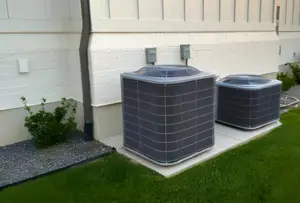Hey there, I want to talk to you in this article, about troubleshooting and fixing common problems with air conditioning (AC) units. We’ve all been there – the AC suddenly isn’t working, and you’re left sweating in the heat. Well, I’ve got a step-by-step approach to help you diagnose and maybe even fix these AC troubles.
Table of Contents
Inside Troubleshooting
Start with the Thermostat
I recommend beginning indoors. Start by checking the thermostat – it’s like the command center for your AC system. Make sure it’s set to cool, and double-check those settings. Don’t forget about the “hold” function – it’s handy for overriding programmed settings.
Checking Thermostat Wiring and Batteries
Wiring is crucial. Those wires in your thermostat play important roles – like R for power, Y for cooling, W for heat, and G for the fan. Some thermostats even need batteries. Pay attention to jumpers and common wires, especially for cooling and power functions.
Ventilation and Airflow Checks
Now, let’s talk about airflow. Set the fan to “on” – this is a simple way to see if the indoor fan is working and blowing air through the vents. It helps pinpoint whether the problem is with the fan motor or something else.
Furnace and Electrical Checks
Don’t forget the furnace’s breaker panel – make sure the power’s flowing to the system. Check for tripped breakers and reset them if needed. Oh, and the control board inside the furnace – if a fuse is blown or there are electrical issues, this is where you might find them.
Troubleshooting the Furnace’s Blower Fan
Give the furnace’s blower fan a look. Reach in and give it a spin – see if there are any obstructions or if the motor feels stuck. A malfunctioning blower fan can mess up airflow, and that affects how well your AC cools.
Air Filter Inspection and Cleaning
Filters matter! They’re usually on the return ductwork. Clean ones keep debris out of your system. Check and change them regularly for the best performance and to avoid airflow problems.
Related: Air Filters Maintenance For Healthy House
Condensation Drain and Coil Maintenance
Did you know your AC removes moisture? That’s where the condensation drain and coil come in. Keep the drain clean to prevent clogs and leaks. And that coil? Keep it clean too – it helps your AC work efficiently.
Outside Troubleshooting
Checking the Condenser Unit
Now, let’s head outside to your AC’s condenser unit. This is where the compressor and condenser fan hang out, doing their cooling magic.
Related: How to Clean Condenser Coils Inside
Contactors and Electrical Checks
Meet the contactor – it’s the switch that controls power to the compressor and fan. Check it for pests, corrosion, or worn-out contacts that can mess with the electricity flow. Safety first, though!
Capacitor Inspection and Replacement
Capacitors give a boost to start the compressor and fans. If one’s bad, it can mess with starting. Look for bulging or leaks – signs of a bad capacitor. Swap it out if needed – it’s connected to fan and compressor operation.
Fan Motor and Blades Inspection
Your condenser fan motor is a big deal – it helps get rid of heat from the coil. Give it a spin by hand to check if it’s moving freely. Remember to oil it up for smooth operation and a longer life.
Compressor Examination and Troubleshooting
The compressor is the heart of your AC. If it’s acting up, it can mess with cooling. If you suspect compressor problems, it’s best to get a professional to take a look.
Checking Freon Levels and Leaks
Freon levels matter too. A well-working AC doesn’t need frequent freon refills – it’s a sealed system. If you suspect leaks, call in the experts. Refrigerant leaks can make your AC less efficient.
Conclusion: The Importance of Regular Maintenance
So there you have it – a breakdown of how to troubleshoot and fix AC issues. Remember, regular maintenance is key to preventing these issues and keeping your AC running smoothly. By digging into these troubleshooting steps, you can identify problems and maybe even fix them, ensuring your AC’s efficiency and longevity.









